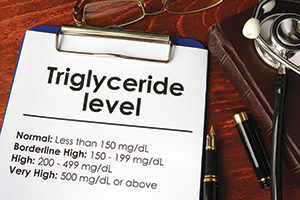13 simple ways to lower your triglycerides and reduce your risk of heart disease
 About 25 percent of adults in the U.S. have elevated triglycerides – a type of fat found in your blood. Triglycerides supply your body with energy, but having too many triglycerides in your blood can increase your risk of heart disease. Obesity, uncontrolled diabetes, regular alcohol use and a high-calorie diet can all contribute to high blood triglyceride levels.
About 25 percent of adults in the U.S. have elevated triglycerides – a type of fat found in your blood. Triglycerides supply your body with energy, but having too many triglycerides in your blood can increase your risk of heart disease. Obesity, uncontrolled diabetes, regular alcohol use and a high-calorie diet can all contribute to high blood triglyceride levels.
Here are some ways to lower your triglycerides:
1. LOSE SOME WEIGHT
Research has shown that losing even a modest five to 10 percent of your body weight can decrease blood triglycerides and have a lasting effect, even if you regain some of the weight.
2. LIMIT SUGAR INTAKE
Added sugar is a big part of many people’s diets.
The American Heart Association recommends consuming no more than six to nine teaspoons of added sugar per day. Hidden sugar commonly lurks in sweets, soft drinks and fruit juice.
3. FOLLOW A LOW-CARB DIET
Much like added sugar, extra carbs in your diet are converted into triglycerides and stored in fat cells. A 2006 study found those who ate a low-carb diet providing about 26 percent of calories from carbs had greater drops in blood triglyceride levels than those given higher-carb diets.
4. EAT MORE FIBER
Including more fiber in your diet can decrease the absorption of fat and sugar in your small intestine, helping to lower the number of triglycerides in your blood.
Fiber is found in fruits, vegetables and whole grains, nuts, cereals and legumes.
5. EXERCISE REGULARLY
“Good” HDL cholesterol has an inverse relationship with blood triglycerides, meaning that high levels of HDL cholesterol can help lower triglycerides.
Aerobic exercise can increase levels of HDL cholesterol in your blood and, when paired with weight loss, is especially effective at decreasing triglycerides.
6. AVOID TRANS FATS
Artificial trans fats are a type of fat added to processed foods to increase their shelf life.
Trans fats are commonly found in commercially fried foods and baked goods made with partially hydrogenated oils.
Due to their inflammatory properties, trans fats have been attributed to many health problems, including increased “bad” LDL cholesterol levels, increased triglyceride levels and heart disease.
7. EAT FATTY FISH TWICE WEEKLY
Fatty fish is well known for its benefits on heart health and ability to lower blood triglycerides.
This is mostly due to its content of omega-3 fatty acids, a type of polyunsaturated fatty acid that is considered essential, meaning you need to get it through your diet.
Both the Dietary Guidelines for Americans and American Heart Association recommend eating two servings of fatty fish per week.
8. INCREASE YOUR INTAKE OF UNSATURATED FATS
Studies show that monounsaturated and polyunsaturated fats can reduce blood triglyceride levels, especially when they are replacing other types of fat.
Monounsaturated fats are found in foods like olive oil, nuts and avocados. Polyunsaturated fats are present in vegetable oils and fatty fish.
9. ESTABLISH A REGULAR MEAL PATTERN
After you eat a meal, the cells in your pancreas send a signal to release insulin into the bloodstream. Insulin is then responsible for transporting glucose to your cells to be used for energy.
If you have too much insulin in your blood, your body can become resistant to it, making it difficult for insulin to be used effectively. Setting a regular eating pattern can help prevent insulin resistance and high triglycerides.
10. LIMIT ALCOHOL INTAKE
Alcohol is high in sugar and calories. If these calories remain unused, they can be converted into triglycerides and stored in fat cells.
Although light-to-moderate alcohol consumption has been linked to reduced risk of heart disease, some studies show that moderate alcohol consumption can increase blood triglycerides by up to 53 percent.
11. ADD SOY PROTEIN TO YOUR DIET
Soy is rich in isoflavones, which are a type of plant compound with numerous health benefits. This is especially true when it comes to lowering LDL cholesterol.
Particularly, soy protein has been shown to reduce blood triglyceride levels.
12. EAT MORE TREE NUTS
Tree nuts provide a concentrated dose of fiber, omega-3 fatty acids and unsaturated fats, all of which work together to lower blood triglycerides.
Tree nuts include almonds, pecans, walnuts, cashews, pistachios, brazil nuts and macadamia nuts. However, keep in mind that nuts are high in calories. A single serving of almonds, or about 23 almonds, contains 163 calories, so moderation is key.
13. TRY A NATURAL SUPPLEMENT
Several natural supplements have the potential to lower blood triglycerides, including fish oil, fenugreek, garlic extract, guggul and curcumin.
Choosing healthy, unsaturated fats in place of trans fats, decreasing your intake of carbs and exercising regularly may help lower your blood triglycerides and improve your overall health at the same time.
(healthline.com)



Leave a Reply